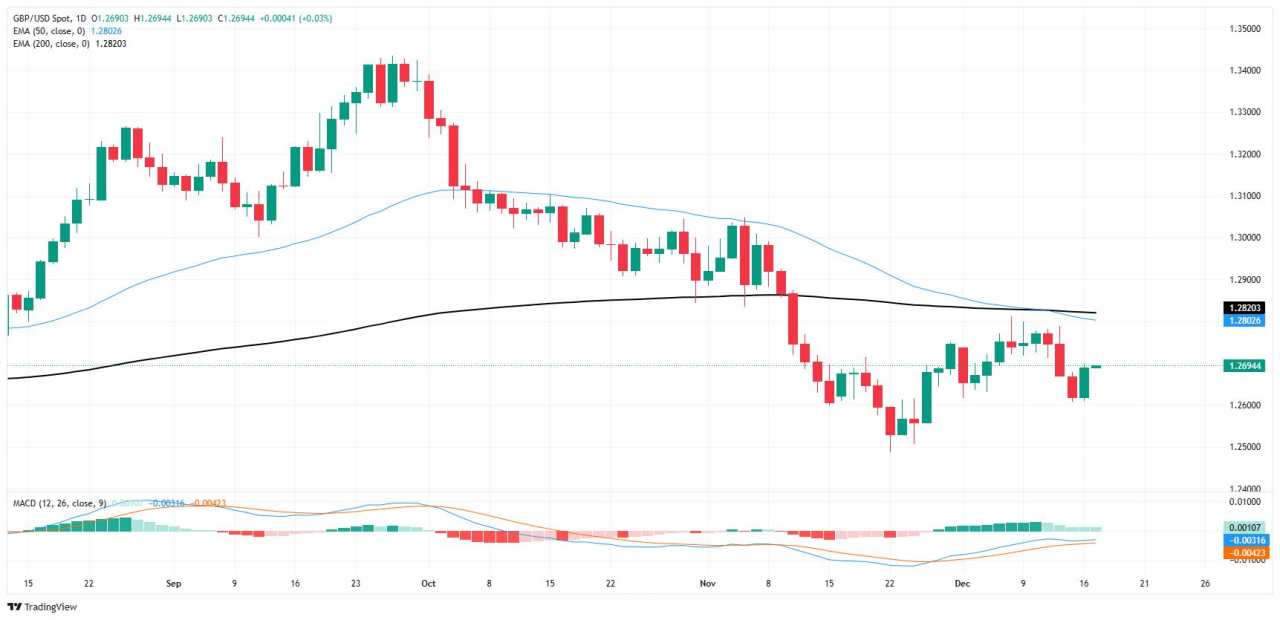GBP/USD pares recent losses as Cable traders brace for central bank outings
- GBP/USD recovered ground on Monday, edging back toward the 1.2700 handle.
- Cable traders are bracing for a tense week with a central bank double-header on the cards.
- The Fed is widely expected to trim rates once more, while the BoE is seen standing pat.
GBP/USD snapped a three-day losing streak that dragged the pair down toward the 1.2600 handle last week, recovering a little over one-half of one percent on Monday and pushing back into touch range of 1.2700.
UK Services PMI survey results hit an 11-month low in December, but a rise in the Manufacturing component supported Cable sentiment. GBP traders will focus on Tuesday’s UK wages and labor data, with quarterly Average Earnings expected to rise to 5% YoY.
Markets await the Fed’s rate decision on Wednesday, with a 25 bps cut fully priced in at 99.1%, per the CME’s FedWatch Tool. Traders will closely monitor the Fed’s updated Summary of Economic Projections (SEP) or the interest rate forecasts from policymakers.
US PMI figures for December were mixed: Services PMI reached multi-year highs, while Manufacturing fell below 50.0, signaling contraction. Retail Sales data will be released Tuesday but may receive limited market attention ahead of the Fed’s final rate decision of the year.
GBP traders will catch a fresh update to UK Consumer Price Index (CPI) inflation figures on Wednesday, with the rest of the Cable market awaiting the Bank of England’s (BoE) latest rate call slated for Thursday. The BoE is expected to hold steady on interest rates in an eight-to-one vote split, with one particularly dovish BoE policymaker expected to vote for another cut.
GBP/USD price forecast
The GBP/USD daily chart reflects a broader bearish trend, with price action remaining capped below both the 50-day EMA at 1.2802 and the 200-day EMA at 1.2820. The downward sloping moving averages reinforce the bearish sentiment, as sellers continue to dominate the market following the pair’s failure to reclaim key resistance levels. The MACD indicator remains subdued, with its histogram showing limited bullish momentum, suggesting that upside attempts could face strong headwinds.
The latest candlestick, a small-bodied green candle, signals a modest recovery after the prior session’s sharp decline. However, the rebound remains limited, with the pair struggling to gain traction above the 1.2700 handle. This price action suggests indecision among traders and highlights the risk of another bearish leg. If sellers regain control, a move toward the 1.2600 support zone appears likely. On the flip side, a sustained break above the 50-day EMA could bring the 1.2820 region into focus, where stronger resistance awaits. Until then, GBP/USD remains vulnerable to downside pressures.
GBP/USD daily chart
Pound Sterling FAQs
The Pound Sterling (GBP) is the oldest currency in the world (886 AD) and the official currency of the United Kingdom. It is the fourth most traded unit for foreign exchange (FX) in the world, accounting for 12% of all transactions, averaging $630 billion a day, according to 2022 data. Its key trading pairs are GBP/USD, also known as ‘Cable’, which accounts for 11% of FX, GBP/JPY, or the ‘Dragon’ as it is known by traders (3%), and EUR/GBP (2%). The Pound Sterling is issued by the Bank of England (BoE).
The single most important factor influencing the value of the Pound Sterling is monetary policy decided by the Bank of England. The BoE bases its decisions on whether it has achieved its primary goal of “price stability” – a steady inflation rate of around 2%. Its primary tool for achieving this is the adjustment of interest rates. When inflation is too high, the BoE will try to rein it in by raising interest rates, making it more expensive for people and businesses to access credit. This is generally positive for GBP, as higher interest rates make the UK a more attractive place for global investors to park their money. When inflation falls too low it is a sign economic growth is slowing. In this scenario, the BoE will consider lowering interest rates to cheapen credit so businesses will borrow more to invest in growth-generating projects.
Data releases gauge the health of the economy and can impact the value of the Pound Sterling. Indicators such as GDP, Manufacturing and Services PMIs, and employment can all influence the direction of the GBP. A strong economy is good for Sterling. Not only does it attract more foreign investment but it may encourage the BoE to put up interest rates, which will directly strengthen GBP. Otherwise, if economic data is weak, the Pound Sterling is likely to fall.
Another significant data release for the Pound Sterling is the Trade Balance. This indicator measures the difference between what a country earns from its exports and what it spends on imports over a given period. If a country produces highly sought-after exports, its currency will benefit purely from the extra demand created from foreign buyers seeking to purchase these goods. Therefore, a positive net Trade Balance strengthens a currency and vice versa for a negative balance.
Reprinted from FXStreet_id,the copyright all reserved by the original author.
Disclaimer: The content above represents only the views of the author or guest. It does not represent any views or positions of FOLLOWME and does not mean that FOLLOWME agrees with its statement or description, nor does it constitute any investment advice. For all actions taken by visitors based on information provided by the FOLLOWME community, the community does not assume any form of liability unless otherwise expressly promised in writing.
FOLLOWME Trading Community Website: https://www.followme.com



Hot
No comment on record. Start new comment.